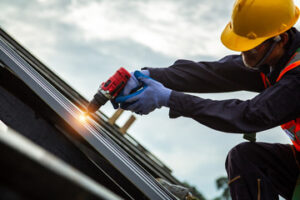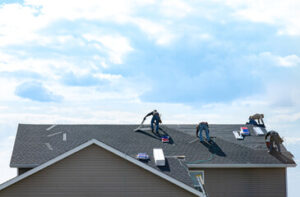When building a deck, you want it to be long-lasting and safe for the people using it. You may also have to meet local code requirements.

Having a plan is key. Even if it doesn’t always work a deck that has something to offer when things go wrong will be much better than one that does nothing. For professional help, contact Deck Builders Lexington KY.
If you’re thinking about building a deck in your backyard this summer, you’ll want to use the best materials for your project. Before beginning your construction, check with local authorities and homeowners association to learn about permits, building codes, inspections, and other requirements. In addition, you’ll need to know about the different types of decking material and their pros and cons.
The most popular decking materials are wood, composite, and PVC. Each type has its own benefits, but you’ll need to consider your budget and maintenance needs when choosing a material. Wood, for instance, is cheaper upfront but requires regular staining and sealing to protect it from the elements. Composite and PVC, on the other hand, have a higher initial cost but minimize future costs and labor with their durability and low maintenance needs.
When planning your deck, you’ll also need to decide on a layout for the structure and how you will use it. For example, if you plan to cook on the deck, you’ll need to consider where you can attach your barbecue and other outdoor appliances. You’ll also need to ensure that you have enough space for people to sit and stand while using the deck.
A deck is a great place to relax, but it can also be difficult to navigate and maintain. To keep your deck in good condition, it’s important to make sure that the railings are secure and that you use high-quality construction materials. In addition, it’s a good idea to stain or paint the railings in a color that complements your home and garden.
When working with pressure-treated lumber, be sure to wear a face mask and work in a well-ventilated area. Wash your hands after handling treated wood and dispose of sawdust according to local regulations. You should also not burn treated wood or use it as mulch. When building a deck, it’s also a good idea to lay out the footprint of your deck before starting construction. This will help you determine the dimensions of the deck and how much materials you’ll need. You can then move on to the next steps, which include digging holes for posts and constructing a frame for the deck.
Design
The design of a deck is a huge part of the build process. This includes how the deck will look, where it’s going to be located in your yard and what features you want to include like stairs or railings. Taking the time to plan out your deck design is a great way to ensure you’re getting exactly what you want.
A few key things to consider when designing your deck are the height, size, complexity and materials used. The overall design can have a major impact on the cost as well. For instance, a simple rectangular deck will be far less expensive than a multi-level, curved structure. Another factor is the deck’s location, as this can impact things like privacy, sunlight and access from your home.
Whether you’re going with a composite or wood deck, the underlying structure will need to be made of a strong material that can withstand the elements. Many deck builders use pressure-treated lumber to provide this. This is an affordable option that will withstand years of use and can be stained or painted to match your backyard. It’s also possible to go with a different material for your decking boards, such as cedar or redwood, which will add a more natural look to the finished project.
Once you have your plans and materials, it’s time to start the construction. For most deck projects, a permit is required to ensure safety and compliance with local codes. If you’re hiring a professional deck builder, they will help secure the necessary permits and handle inspections for you.
Before beginning any deck construction, it’s important to contact your local utilities company to have any underground lines marked. This will prevent you from digging holes where pipes or electrical wires are located and potentially damaging them. This step is even more critical if you’re building a deck on a sloped or uneven site.
Once the skeleton of the deck is built, it’s time to add your finishing touches. This can be as simple as adding some plants or as complex as installing a hot tub or outdoor kitchen. No matter what kind of deck you’re creating, the right accessories can turn it into a space that’s both beautiful and functional.
Layout
Decks can be more than just a space to grill and relax, they also can serve as a way to create a focal point in your backyard. Often, people add dining tables for outdoor seating, entertainment assets like fire pits and hot tubs, and even a private sitting area or gazebo to make the space feel more inviting. A livable yard is prized on buyers’ lists when looking for a home, so it can be an investment that boosts resale value.
It’s important to think about how you plan on using your deck before beginning construction. You can do this by mapping out the general layout of your deck and measuring its size. The measurements you take will help guide your planning and ensure the materials you purchase are correct. Once you’ve determined the dimensions of your deck, you can begin to build the framing. For this part of the project, you will need deck screws, a drill, and a tape measure. To prevent weeds from growing up through the gaps between your deck boards, you can use a piece of landscaping fabric over the top of the frame to cover any dirt or grass. Once the frame is built, you can start installing the deck boards. It’s best to start at one end of the deck and work your way across, double checking each board as you go. This will help to keep the boards straight and ensure that they are fastened properly.
Depending on the makeup of your yard and house, you may need to install stairs or a railing to access your deck. You can do this yourself or hire a professional. Adding a staircase can add to the cost of your project and be difficult to DIY, so it’s important to weigh the pros and cons before making this choice.
The deck stair calculator on Family Handyman’s website can help you determine the number of steps and risers you need for your staircase. It’s important to mark your deck stair layout with strings and batter boards (made of 2-foot furring strips) before beginning the construction process. These are easy to install and help ensure the stair frame is square.
Installation
A deck is an additional living space for your home, so it’s important that it be safe and secure. The best way to ensure this is to follow the construction process carefully and work with a professional deck builder if you are unable to do it yourself. A pro will know how to source materials, draft construction plans, and work with building inspectors to ensure your deck is sturdy and meets local codes. In addition, a professional will be able to work fast to get the job done.
The first step is to lay out a foundation for the deck. Depending on the design of your deck, this may include a ledger board, footings, or concrete piers. If your deck is attached to the house, you must use flashing to prevent water from damaging the critical connection between the deck and your house. A professional will install this correctly to avoid rot and mold problems.
Once the footings are in, a support beam is installed on top of them. The end of the beam is either attached to the ledger board with joist hangers or rests on the deck itself, depending on your deck’s design.
Next, you install the principal joists of the deck. These will be spaced according to your deck plans and the load requirements specified by your building inspection office. A small deck may call for joists made from 2 x 6 lumber, while larger ones require 2 x 10 or 2 x 12 lumber to meet load calculations.
The final phase is to install the decking and railings. Once the decking is in place, you can install furniture and other accessories to make the area more comfortable and enjoyable. You should regularly inspect the deck for warping or damage, and you should use weather-resistant outdoor furnishings to protect your investment.
If you choose to build a deck yourself, be sure to wear eye and mouth protection when working with wood. In addition, use metal fasteners and connectors that are rated for pressure-treated wood to avoid corrosion. Also, don’t forget that pressure-treated wood expands and contracts with moisture, so you need to allow for this expansion and contraction when cutting and nailing.


